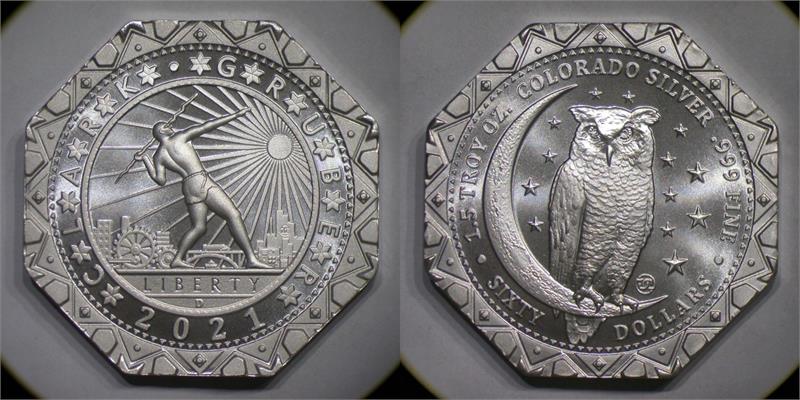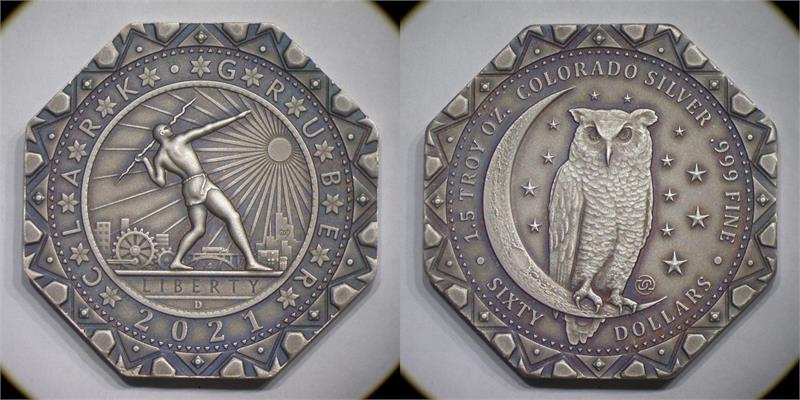1922 low relief matte proof peace dollar
 Melior_Invenidiste
Posts: 123 ✭✭
Melior_Invenidiste
Posts: 123 ✭✭






2
 Melior_Invenidiste
Posts: 123 ✭✭
Melior_Invenidiste
Posts: 123 ✭✭






Comments
Where did you find that?
Too bad about that spot on the reverse.
Interesting.
congrats on your find - although it has the look to me as a chinese counterfeit
Looks to me like a smoothly worn, typical 1922 Peace dollar.
In honor of the memory of Cpl. Michael E. Thompson
That was my first reaction as well.
I got that at an estate sale
Go in, say your going to buy rooms. Buy the whole room, a cheap one. Then ask for any coins. Pick out. Say you’re coming back for the rest of the rooms later.
Not a proof, and probably not silver. Weight?
Why do you believe this coin is a matte proof?
Experience the World through Numismatics...it's more than you can imagine.
Sounds like a lot of BS to simply purchase an altered Buffalo nickel along with a damaged Peace dollar.
Let's see, 1922 matte proof Peace dollars....... Coin Facts says that 5-8 are suspected to exist. I've held and examined a couple of them. Your new estate sale "discovery" will not cause that number to change. You'll be lucky if it's even made of silver.
I agree with you. It is made of silver but dipped. Brought it into natural light, def not a matte proof, not even close. Tail between the legs, don’t hit too hard. You’ve polished my die on this one enough. Lol.
Best part of this whole post! I LOL’ed.
At first glance it looks like a chinese fake to me the "ghost type" tone. I have been wrong before.
BST transactions: dbldie55, jayPem, 78saen, UltraHighRelief, nibanny, liefgold, FallGuy, lkeigwin, mbogoman, Sandman70gt, keets, joeykoins, ianrussell (@GC), EagleEye, ThePennyLady, GRANDAM, Ilikecolor, Gluggo, okiedude, Voyageur, LJenkins11, fastfreddie, ms70, pursuitofliberty, ZoidMeister,Coin Finder, GotTheBug, edwardjulio, Coinnmore, Nickpatton, Namvet69,...
It is a genuine 1922 Peace silver dollar. But not a matte proof.
The appearance of it is similar to what I achieve when I antique a newly-minted item.
Like this:
As struck:

After antique process:

In other words, I could take any ordinary Peace Dollar and make it look like the coin posted.
Slightly heat the coin. Apply shoe polish. Let dry. Buff off the excess.
Or, perhaps the method has improved over the last couple of decades?
I’m just going to live long enough to see mine antique slowly
You might try acetone to remove the stain on the reverse.... Might work, might not..... Good luck. Cheers, RickO
Anyone know how the mint antiqued the genuine 1922 High Relief proof Peace $?
If I were going to try to fake this look I think I would pickle the coin in Jewelluster for several days, turning it over every day so that the acid gets at both sides equally. Then add the darkening agent and buff.
Are you speaking of their typical finish? If so, they were sand-blasted. If you're asking about something else, I'm largely clueless.
Mark Feld* of Heritage Auctions*Unless otherwise noted, my posts here represent my personal opinions.
@MFeld, there is a 1922 High Relief dollar in an antiqued finish certified by our hosts. There is also a 1921 entry. You can see the CoinFacts page for the 1922 by typing “PCGS 97382” into your browser. Other than that I can’t help answer the question about how it was produced.
is this it? Does it have 8 rays under the tail?
Thank you, @FlyingAl.
Here's a link to the Heritage auction description of the coin: https://coins.ha.com/itm/proof-peace-dollars/1922-1-high-relief-sandblasted-antique-finish-judd-2018-r8-sp64-pcgs-secure/a/1291-4604.s
I have copied part of the description below - please see the last paragraph, which I think might partially answer the question posed by @Floridafacelifter.
The Present Coin
Judd-2018 was unknown in 2005, when Roger Burdette published his excellent Renaissance of American Coinage, 1916-1921. However, Burdette published a letter on page 219 of his reference from Philadelphia Mint Superintendent Freas Styer to Mint Director Baker that reveals the origin of the present coin:
"Sir:
As per your request I am enclosing herewith two Peace dollars, one of the coinage of 1921 and one of 1922, with reduced border, sand blasted and finished to show all the details of the work.
"I am also enclosing two other pieces, one of the coinage of 1921 and one of 1922, both being bright pieces, for comparison.
"I will thank you to return these coins when they have served your purpose.
"We have just tried a stack of twenty pieces of the coin with the reduced border against twenty coins of the old design and find very little difference between the two stacks, the 'Peace' dollars being very slightly higher than the old.
"For your information will say the dies shipped to San Francisco and Denver are similar to those from which the coins of 1922 herewith enclosed were struck.
"Respectfully,"
We believe this coin, from the estate of Mint Director Raymond T. Baker, is the second piece referenced in the letter above, the 1922 High Relief Peace dollar that was sandblasted and treated with an antique charcoal finish to accent the fine details of the design. A specimen of the 1921 High Relief Peace dollar, also from Baker's estate, was offered in a Stack's Bowers auction in 2014. That coin features the same antique finish as the present piece, a finish that is unique to these two specimens in the entire Peace dollar series. Undoubtedly, that piece is the first coin mentioned in Styer's letter.
Mark Feld* of Heritage Auctions*Unless otherwise noted, my posts here represent my personal opinions.
I just had two questions about these two coins in particular:
1) I wondered what they used to antique the sandblasted antiqued example below:


2) And the one below is just sandblasted but if you look at the rim at 9 o’clock it looks like the grayish coating is rubbing off- does sandblasting coat the surface of the coin with something- I just thought it roughed up the surface and made it look sandy
@Floridafacelifter For your second question, no matter what proof process the mint applied, the finish should not just rub off. The mint used three different full finished for proofs in this time period- Satin, Sandblast, and Matte. I’m sure you’ve heard of these. I have heard different processes were used for different coins, but am not sure what was used for this coin. It appears to me that the dies were sandblasted for this one and the rubbing you notice is just toning.
This is how I understand it:
If the coin was a Satin proof sandblasted after striking, it is a Sandblast proof with a finish identical to the Sandblast gold produced 1911-1916. If the dies were sandblasted, the coin is a Matte proof. If the coin was struck by dies without any special preparation with no special finish done afterwards, it is a Satin proof.
Either way, the finish should not rub off since the sandblasting for Sandblast proofs is a pitting process to the coin that changes the surface, or the dies should have been permanently altered. However, contact with other coins could create a mark that would change the surface to where it is not the same as the rest- the mark could cause a mirror surface in theory.
Thank you very much for a simple yet elegant explanation that makes a lot of sense. I actually think coin #2 is classified as a Matte Proof and the shiny spot at 9 o’clock must just be a contact mark
@Floridafacelifter Glad I could help! I also think that it is a Matte proof, it is not grainy enough to be a Sandblast proof and not reflective enough for a Satin proof.
Not proof. MS62, like it says on the label.
Keeper of the VAM Catalog • Professional Coin Imaging • Prime Number Set • World Coins in Early America • British Trade Dollars • Variety Attribution
And a low end one at that
11.5$ Southern Dollars, The little “Big Easy” set
in here: there's at least 2 different coins - none are proof, matte, satin, sandblasted or anything other than regular coins
I agree with the other opinions- regular MS coin